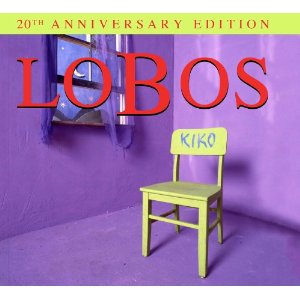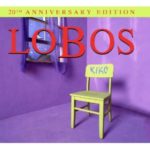
Shout! Factory
The release of Kiko 20 years ago by Los Lobos wasn’t just the opening of a door – they knocked the damn thing right off the hinges. At that point in their career (with 7 albums and a couple of Grammy awards under their belts) the self-described “just another band from East L.A.” were an established commodity: multi-faceted rockers who wove their Latin roots proudly throughout the music they made.
Kiko, however, was something different. Kiko was the sound of a musical brotherhood rolling up their sleeves, opening up their minds, and going for it. The process began with solid songs (the bulk of them co-written by David Hidalgo and Louie Perez with Cesar Rosas contributing, as well). The band as a whole applied dollops of funk, folk, psychedelia, blues, gravel, grit, grease, brilliant sunshine, and shades of darkness to the music. The raw materials were then placed in the hands of producer Mitchell Froom and engineer Tchad Blake. The results were brilliant – and 20 years later, they still are.
The opener “Dream In Blue” is propelled by a Bourbon Street-flavored rhythm, but the vibe is more L.A. than LA. At the song’s midpoint, the percussion steps to the forefront, bumping hips with Conrad Lozano’s bass and Steve Berlin’s sax – until the whole works is enveloped by a total guitar freakout by Rosas, hurtling to what seems to be certain disaster. Bump; crash; a squeal of feedback – and the band lands on its feet, shimmying to the song’s original groove. The original album ended with the drunken carousel wobble of “Rio De Tenampa” – the drums and horns colliding on the main theme in a weirdly-balanced waltz. And in between is a little bit of everything. (The 20th Anniversary version offers a couple of studio demos and three live tunes – tasty, but almost a distraction to the flow of 1992’s 16 cuts.)
“That Train Don’t Stop Here” is a way-cool blues with Rosas’ guitar in the left channel doing a killer B-3 imitation until it takes off its disguise to swap licks with Hidalgo. “When The Circus Comes To Town” is sweet, sad, and proud; Hidalgo’s accordion on “Kiko And The Lavender Moon” is haunting, captivating, and weirdly funky. Bass and drums stalk the guitars skidding and lurching through “Wicked Rain”; the main riff of “Peace”’ walks with a cool swagger, slapping palms with the horns and guitars as it makes its’ way to a certain end; and when Louie Perez leads the way through the lovely roundy-round swirl of “Saint Behind The Glass” the depths are deceiving. Listen with one set of ears and hear folk ballet; go a little deeper and you find rhythms that come from someplace else … unexpected, but perfect.
And therein lies the key to Kiko – the unexpected sonic twists; the unexpected poetic beauty; the unexpected mirror that reflects things we thought couldn’t be seen.
It still offers all those things, 20 years later.
Meanwhile, the also-newly-released Kiko Live finds Los Lobos on stage at San Diego’s House Of Blues in February of 2006, playing a start-to-finish performance of their masterpiece 14 years later. (Separate DVD and Blu-Ray versions are also available.) The studio talents of Froom and Blake were key to the original album’s sound; here, whatever might be given up in technological wizardry is more than made for by sheer musicianship.
“Arizona Skies” soars on the back of Hidalgo’s slide-and-fret work on the 8-string jarana; “Saint Behind The Glass” is allowed to flow as guest Angel Abundez’ harp breaks the heart of everyone in the House Of Blues; Perez joins drummer Cougar Estrada on percussion to give an added touch of drama to “Two Janes”; Lozano’s bass line on “Wake Up Delores” should be put in a can and labeled “Cream Of Groove”. Some numbers on Kiko Live are played fairly close to the originals in terms of length, but even then it’s the extra tug of a horn line, the in-the-moment delivery of a vocal, or the squeal of a just-barely-held-in-check guitar that takes the music somewhere new.
The truly amazing moments on Kiko Live are when Perez, Rosas, and Hidalgo all have guitars strapped around their shoulders; add in Berlin on sax and you have a front line capable of just about anything (with Lozano and Estrada in the engine room). Highlights include “Just A Man”, a 9-minute-and-40-second excursion deep into the heart of the blues, while “Peace” slowly but surely evolves into a psychedelic sonic somersault with all three guitarists venturing into the Land Of Beautiful Apeshit.
In short, consider the studio Kiko as a magnificent record of this music’s birth – its baby book, if you will. Kiko Live offers the matured tunes in a no-holds-barred setting with plenty of jam on the side. Both are essential listening.



No Comments comments associated with this post